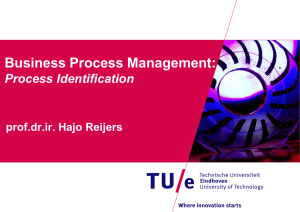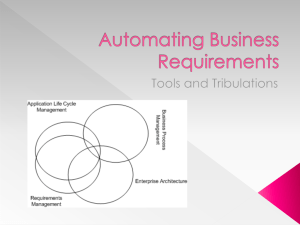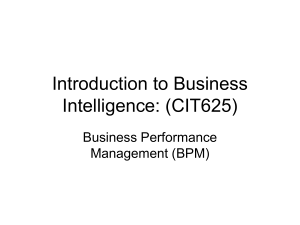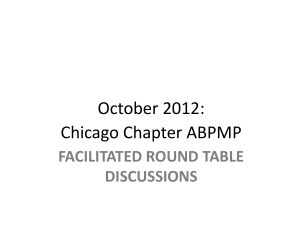BPM - abpmp
advertisement
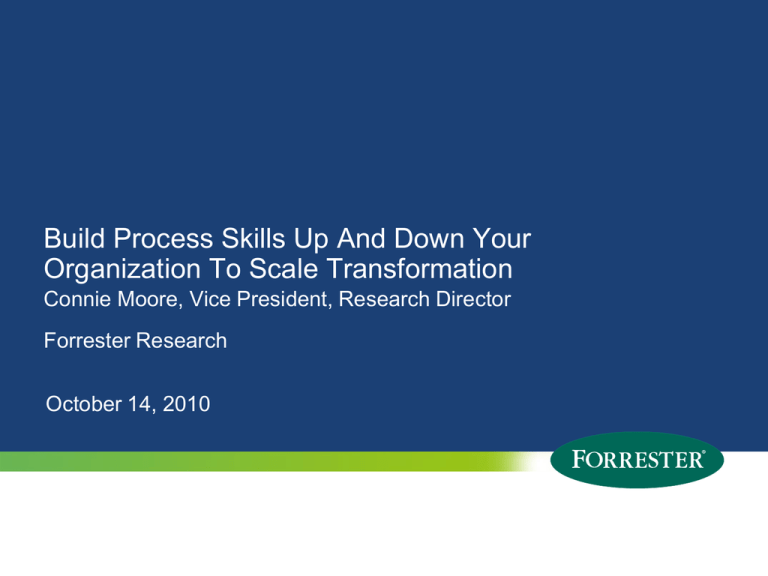
Build Process Skills Up And Down Your Organization To Scale Transformation Connie Moore, Vice President, Research Director Forrester Research October 14, 2010 1 © 2009 2010 Forrester Research, Inc. Reproduction Prohibited Business Process pros are at the center of business transformation . . . . . . but need new skills to be successful. 2 © 2010 Forrester Research, Inc. Reproduction Prohibited Business process professionals stand at the crossroads between business and IT . . . 3 © 2010 Forrester Research, Inc. Reproduction Prohibited Imagine . . . producing a musical with new actors Source: Flickr (http://www.flickr.com/photos/cyndipix/4366759809/) 4 © 2010 Forrester Research, Inc. Reproduction Prohibited Different views of business processes Focus on automation, not the process 5 • Groping toward new roles for process analysis and architecture © 2010 Forrester Research, Inc. Reproduction Prohibited • Process group has deep knowledge in Lean and Six Sigma Meet the business process team . . . Change agent Prodigy 6 © 2010 Forrester Research, Inc. Reproduction Prohibited Guru Wannabe Operator Most business process improvement is driven by business execs March 5, 2010 Business Process Pros Hold The Key To 21st Century Business Transformation, Forrester Report 7 © 2009 2010 Forrester Research, Inc. Reproduction Prohibited Business process pros need better ways to learn and develop skills “Where do you turn to for learning/developing business process management skills?” (Check all that apply) Base: 83 IT professionals involved in BPM or process improvement projects Source: May 2010 Global Process Management/Improvement Online Survey 8 © 2010 Forrester Research, Inc. Reproduction Prohibited What do “change agents” need? Strong business case A peer-to-peer network BPM center of excellence Clear understanding of Lean, Six Sigma, and BPM 9 © 2010 Forrester Research, Inc. Reproduction Prohibited “Change agents” must evangelize, monetize and communicate, communicate, communicate! “The change agent is in a never-ending quest for sponsorship.” -Kenny Klepper, COO Medco “The change agent must take cost out of the business to fund transformation.” -Kenny Klepper, COO Medco 10 © 2010 Forrester Research, Inc. Reproduction Prohibited “I definitely spend a lot of time talking to the business about what [it needs]. What is working? What isn’t working?” -Sr. manager, large bank The journey to transformation follows several stages Management area Strategy • Objectives • Scope • Value Process gov. • • • • Life-cycle budget Decision-making Portfolio Waste Org. structure • Gov. bodies • Demand • Service mgmt. Performance • Measurements • Communications Culture • Cultivated skills • Environment • Orientation Maturity level 1 Level 2 Level 3 Level 4 Maturity level 5 Ad hoc Inconsistent Defined Managed Optimized (BT) • Integrated business and IT plans • BPM plans focused on value chain innovation and transformation • Customer value synchronized with corporate performance Ad hoc planning, weaklink business, and IT objectives Mature No evaluation process, arbitrary decisions, no link from investments to resource commitments No steering committee, projects funded on request, no formal biz relationship Aspiring • Enterprise portfolio, biz metrics • Local and global decisions coordinated • BPM investments cross-linked to performance • Proactive waste elimination • Appropriate levels of investment, sponsorship, and involvement • Demand incorporates C-level decisionmaking • BPM through shared services IT tracks operational metrics, not business measures; communication on request • Board-level and investor monitoring of tech business results • Transparency provided to employees, management, investors, and partners Technical skills limited to specific tasks, few cultural norms, reactiveImmature orientation • Businesswide education and careers • Strong brand and reputation • Entrepreneurial orientation • Emphasis on customer outcomes and behavior January 20, 2010 A Lean Business Technology Maturity Matrix For BPM Governance, Forrester Report 11 © 2010 Forrester Research, Inc. Reproduction Prohibited Another way to look at BPM maturity lower higher higher BPM adoption maturity Process Optimization Transformation Business insight Value to shareholders Process monitoring Compliance & consistency Process Execution IT agility SOA Efficiency Knowledge lower Workers, supervisors and managers CIO Customers and partners 12 Level of Stakeholders © 2010 Forrester Research, Inc. Reproduction Prohibited CFO CXO CEO Change agents must move the org from function to services & processes Vertical / Functional Functional / Process Overlays From Traditional Line Management 13 © 2010 Forrester Research, Inc. Reproduction Prohibited Process / Functional Service / Process Overlays Organisation To Processes & Services Management Medco has fully embraced this new business model BP COE — technologists working with next-generation, configurable solutions Business innovation and agility centers — combination of IT/BT, looking at marketplace demand, for growth and differentiation Business operations — operational excellence for the company Operational owners — internal focus across the business process 14 © 2010 Forrester Research, Inc. Reproduction Prohibited Including . . . new job titles Business innovation and agility leaders Process champions (operational owners) CoE leaders (responsible for construction of business process capabilities) Deeper in the organization: 15 © 2010 Forrester Research, Inc. Reproduction Prohibited - Modelers (focus is on user experience, in operational and business groups, some in IT) - Business architects (in business and IT) - Designers (technologist) One “change agent’s” perspective on people skills “We leaned very heavily on our vendor for professional services; now we’re standing on our own two feet.” “The number of people Who know about this technology is scarce and expensive.” CIO, financial services company “It takes people time to get up to speed” 16 © 2010 Forrester Research, Inc. Reproduction Prohibited COEs often start small A financial service company's COE started with: – four developers – one business analyst – one enterprise architect. 17 © 2010 Forrester Research, Inc. Reproduction Prohibited CoEs evolve over time as maturity grows CIO or Governance Council IT Exec C Level Exec Line Of Business BPM BPM BPM CoE BPM CoE BPM CoE CoE CoE BPM CoE Process Methods & Tools Business Case Development Business Architecture 18 © 2010 Forrester Research, Inc. Reproduction Prohibited BPM Project Management BPM Suites Process Analysis/Modeling Training Potential CoE service portfolio Facilitate process governance – Portfolio management and prioritization of BPM roadmap – BPM maturity assessment – Budget allocation – Track benefits delivery; Reuse Business architecture – Overall process architecture – Global v local guidelines – M&A support Manage organizational change 19 – Organizational role definition and workforce planning – Rationalize other CoEs (Lean, Six Sigma, BSC, etc) – Institutionalize process improvement methods © 2010 Forrester Research, Inc. Reproduction Prohibited Manage BPM projects – Develop project business cases – Education & training support to the BPM project Model & analyze processes – Rationalize metrics, dashboard and scorecard creation – Simulate potential changes – Business rules development Advise on IT integration – Develop library of integration components – Master data management Assess technology, methods, tools, standards – Train & develop specialists – Knowledge management COEs need a blend of technical and business skills “[You] can do this without code — that’s true — but it doesn’t mean a business person can do it.” “[You] can’t create a business process without a software engineering background — [you] need to know how functions work; [you] need to know how loops work.” “These suites still require you to have [a] software engineering skill set.” 20 © 2010 Forrester Research, Inc. Reproduction Prohibited CIO, large financial services company But, BPM competency centers are not ubiquitous “Do you have a BPM competency center?” Don’t know 6% “What types of individuals staff your BPM competency center?” (Check all that apply) Yes 37% No 57% Base: 83 IT professionals involved in BPM or process improvement projects Base: 31 IT professionals involved in BPM or process improvement projects who have a BPM competency center Source: May 2010 Global Process Management/Improvement Online Survey 21 © 2010 Forrester Research, Inc. Reproduction Prohibited SaaS is one way to ramp up quickly with limited IT/process skills • Goal: efficient and profitable • SaaS BPM allowed an incremental approach. – Promotion by promotion – Paced by business users – 12 weeks for development • Minimal involvement from IT 22 © 2010 Forrester Research, Inc. Reproduction Prohibited What do “process gurus” need? Sometimes, it’s BPM 101 they need (Lean experts) Business process role separated from enterprise architects Certification Great process analysts 23 © 2010 Forrester Research, Inc. Reproduction Prohibited One guru’s perspective “The biggest challenge is how to develop really good process architects. . . ” “[I] don’t think there is a training or certification program where you can send a process architect.” Manager, BPM COE “When a company is in the earlier stages and doesn’t have the expertise, [it] will need at least some transitional assistance with process architecture.” 24 © 2010 Forrester Research, Inc. Reproduction Prohibited What do “prodigies” need? Pairing with a vendor expert for knowledge transfer Certification training Pairing with a business analyst or SME for learning 25 © 2010 Forrester Research, Inc. Reproduction Prohibited “Gurus” and “prodigies” have different expertise “The process analyst facilitates and manages process improvement efforts. “The business architect is highly influential and a master facilitator. “They receive guidance from the business architect. They ‘own’ keeping the views of their respective architectures up to date.” “They usually analyze one process and have limited ability to see beyond the effort in front of them.” Director of BPM, global manufacturer 26 © 2010 Forrester Research, Inc. Reproduction Prohibited Lean, Six Sigma are most important to BPM pros “How important are these methodologies/certifications to your organization’s BPM skills development?” Base: 83 IT professionals involved in BPM or process improvement projects Source: May 2010 Global Process Management/Improvement Online Survey 27 © 2010 Forrester Research, Inc. Reproduction Prohibited BPM, Lean and Six Sigma: Better Together BPM provides BPM provides the framework ..to manage change in process and workflow models BPM BPM provides the environment to support the speed of change BPM tools and technology can expedite the adoption of a process centric view ... Some view Lean and Six Sigma and BPM as competing disciplines Lean and Six Sigma can provide insight and the Lean measures to support potential improvements and Six Sigma Lean Six Sigma target inefficiency with a broad range of tools and toolkits All 3 are complimentary and can be leveraged to achieve greater results 28 © 2010 Forrester Research, Inc. Reproduction Prohibited • Framework • Environment •Tools to accelerate Lean and Six Sigma provide Methodology Insight Metrics Source: Gabrielle Field, ABPMP, Raymond James Financial What do “wannabes” need? Realistic expectations Pairing with a process expert for at least two to three months 29 © 2010 Forrester Research, Inc. Reproduction Prohibited One change agent’s view on process analysts “Process experts are a rare type of talent.” “We thought the traditional business analyst would be the right source, but we were horribly disappointed.” BPM director, large automotive manufacturer “When people don’t get it, they don’t ever get it. Either people have the makeup to be in a colocated, intensive environment or they don’t.” 30 © 2010 Forrester Research, Inc. Reproduction Prohibited Retool the business analyst Today’s tools are inadequate. – Most still rely on Word, Excel, and Visio. Requirements management tools are: – Too complex and not user friendly. – Too costly to purchase and administer. – Too text centric, without support for rich, graphical artifacts. – Too siloed — lacking integration with other tools. 31 © 2010 Forrester Research, Inc. Reproduction Prohibited Process skills are migrating out of IT Business Human domains resources expert Finance & accounting expert High Procurement expert Sales expert Operations expert P r o c e s s VP of business process improvement Business architect Process architect and analyst Manager of IT business systems Evolving business analyst Business process COE Manager of IT business systems Evolving BA Process and information architects Traditional BA IT Application development Enterprise architecture m a t u r i t y Low 32 © 2010 Forrester Research, Inc. Reproduction Prohibited The next 90 days • Immature: • Investigate how big your process initiatives are • Look at SaaS BPM to jump-start skills • Aspiring: • Conduct a process skills assessment; involve HR. • Assess how you develop new skills (mentoring, pairing, training). • See how effective cross-training is in the COE. • Consider in-house training on BPM, Lean, and Six Sigma. • Look at ABPMP certification. • Mature: • Add BPM to your training Entire contents © Forrester 2010 Forrester Research, Inc. All rightsProhibited reserved. 33 33 © 2010 Research, Inc. Reproduction Longer term •Immature •Consider a BPM COE if there are enough projects to warrant. •Aspiring •Consider creating your own in-house certification program. •Work with HR to develop career paths, training programs, and new job titles. •Focus on IT and business training/development. •Focus on senior-level jobs in addition to architect/analyst jobs. •Mature •Make sure BPM is properly positioned and understood within the company. Entire contents © Forrester 2010 Forrester Research, Inc. All rightsProhibited reserved. 34 34 © 2010 Research, Inc. Reproduction Source: Flickr (http://www.flickr.com/photos/apricoco/2170468475/) 35 © 2010 Forrester Research, Inc. Reproduction Prohibited Thank you Connie Moore +1 540.882.4040 cmoore@forrester.com @cmooreforrester http://blogs.forrester.com/connie_moore www.forrester.com © 2009 Forrester Research, Inc. Reproduction Prohibited Recommended reading for change agents Warren Bennis, On Becoming a Leader James C. Collins, Good to Great Rick Delbridge, et al., The Exceptional Manager: Making the Difference George Eckes, The Six Sigma Revolution Tom Hayes, Jump Point: How Network Culture is Revolutionizing Business John C. Jeston, Beyond Business Process Improvement, On To Business Transformation: A Manager’s Guide Edgar H. Schein, Organizational Culture and Leadership James P. Womack and Daniel T. Jones, Lean Thinking: Banish Waste and Create Wealth in Your Corporation 37 © 2010 Forrester Research, Inc. Reproduction Prohibited Business and process architects/analysts should read these Yvonne Lederer Antonucci, et al., Business Process Management Common Body Of Knowledge John Bicheno, The New Lean Toolbox Barry Boehm and Richard Turner, Balancing Agility and Discipline: A Guide for the Perplexed David M. Dikel, David Kane, and James R. Wilson, Software Architecture: Organizational Principles and Patterns John Jeston and Johan Nelis, Business Process Management: Practical Guidelines to Successful Implementations Eberhardt Rechtin, Systems Architecting: Creating & Building Complex Systems Andrew Spanyi, Business Process Management (BPM) is a Team © 2010 Forrester Research, Inc. Reproduction Prohibited 38



